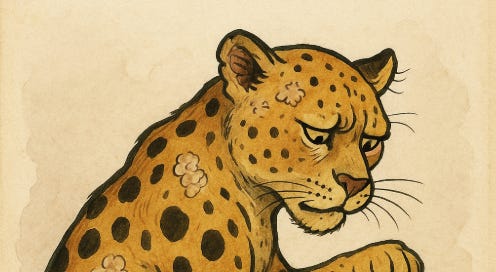A Censored Seforno: Tzaraat as a Natural Disease?
When it comes to tzara’t, you will often find two approaches within Biblical commentators. Some will say that (A) this set of diseases corresponds to natural diseases to which we can point. Others will say that (B) these are entirely spiritual phenomena. Both approaches can be frum and non-heretical. For instance, regarding A, Hashem expresses His displeasure via a natural phenomenon, and associated tum’a with this disease’s manifestation. The disease can be sparked by a sin that the person did. Still, it makes sense that those who maintain B would regard A is being theologically problematic.
It seems that Seforno is a proponent of approach A, which presents a problem for Eliyahu Munk as he translates a certain comment.
The pasuk in question is Vayikra 13:2:
אָדָ֗ם כִּֽי־יִהְיֶ֤ה בְעוֹר־בְּשָׂרוֹ֙ שְׂאֵ֤ת אֽוֹ־סַפַּ֙חַת֙ א֣וֹ בַהֶ֔רֶת וְהָיָ֥ה בְעוֹר־בְּשָׂר֖וֹ לְנֶ֣גַע צָרָ֑עַת וְהוּבָא֙ אֶל־אַהֲרֹ֣ן הַכֹּהֵ֔ן א֛וֹ אֶל־אַחַ֥ד מִבָּנָ֖יו הַכֹּהֲנִֽים׃
When a person has on the skin of the body a swelling, a rash, or a discoloration, and it develops into a scaly affection on the skin of the body, it shall be reported to Aaron the priest or to one of his sons, the priests.
Seforno comments:
שאת או ספחת או בהרת. כלם מיני צרעת ומראיהן לבן כמו שבא בקבלה. ואין בהן ממיני הצרעת שספרו הרופאים זולתי המורפיא"ה והאלבארם והנתק. אמנם שאר מיני הצרעת החזקים שספרו, שהם סרטן לכל הגוף בכלל, והם נוטים אל האודם והשחרות, לא תטמאם התורה כלל.
כי אלה הד' מראות לבדנה שספרו ז"ל שהן שאת ותולדתה, בהרת ותולדתה באות בתוכחות על עון, כאמרם ז"ל: (ברכות ה, ב) כל שיש בו אחד מד' מראות הללו אינן אלא מזבח כפרה
אבל שאר מיני הצרעת שספרו הרופאים לא יהיו בעמנו כלל על צד מזבח כפרה, אם לא יהיה עמנו בתכלית הקלקול חס ושלום כשאר מדוי מצרים הרעים, או מצד חטא בהנהגת המאכל והמשתה וזולתם, ולא תהיה בהם טומאה כלל.
which I would personally translate as:
שְׂאֵ֤ת אֽוֹ־סַפַּ֙חַת֙ א֣וֹ בַהֶ֔רֶת — all of these are types of Tzara’at (“leprosy”), and their appearance is white, as comes to us through tradition. And, there is not within them of the types of Tzara’at (“leprosy”) which the [modern] doctors relate, except for morphea, albarus [Hansen’s Disease], and netek [the Hebrew word for scaly patches on the head or beard; since these all are white]. However, the other types of severe Tzara’at / leprosy which they relate, which are a sartan [spreading affliction] spreading across the entire body, and they tend towards redness and blackness, the Torah does not declare them ritually impure at all.
For these four appearances which Chazal related, which are שְׂאֵ֤ת and its subtype, בַהֶ֔רֶת and its subtype come as reproof for iniquity, as Chazal said (Berachot 5b), “If one has any of the four signs of leprosy (Leviticus 13) they are nothing other than an altar of atonement.”
However, the other types of Tzara’at / leprosy which the [modern] doctors relate do not exist in our nation at all by virtue of the “altar of atonement”, unless it be in us for the purpose of kilkul / corruption, Heaven forfend, like the evil afflictions / diseases of Egypt [see Devarim 7:15], or by virtue of sin / erring in the behavior of eating and drinking and the like, and there is no ritual impurity in them at all.
It is not entirely clear what Seforno is saying. He definitively rejects most of the forms of “leprosy” as being Biblical tzaraat which carries tum’a. However, I think the three that he identifies as being white, DO correspond to Biblical leprosy, have an aspect of “altar of atonement”, and do carry tum’ah. That is effectively approach A.
Here is how Eliyahu Munk translates this Rashbam. Bolding mine.
שאת או ספחת או בהרת, different skin afflictions, the common denominator being that they are of different shades of white. We base ourselves on the oral tradition as spelled out in Nega-im 1,1. None of these phenomena correspond to the skin diseases we read about in medical text books. Such phenomena as are mentioned in these textbooks do not result in the afflicted person being considered ritually impure, nor are they subject to the priest deciding if indeed the symptoms require isolation of the afflicted person and when such symptoms can be declared as having disappeared. According to Berachot 5 the only skin afflictions which may be viewed as G’d’s reminder to improve our lifestyle are the four kinds mentioned in our chapter. While they are not classified as afflictions revealing G’d’s love for the person thus afflicted, they are however, described as מזבח כפרה, as “an altar serving as stepping stone to atonement for the character weakness that the afflicted person has to overcome.” G’d does not employ any other medically well known skin diseases as His instrument to call us to order for various sins committed.
He rewords the beginning, about different shades of white, thus being able to omit the exceptions. Namely, what I rendered above as “except for morphea, albarus [Hansen’s Disease], and netek.” Instead, he says that “None of these phenomena correspond to the skin diseases we read about in medical text books.” Yes, he also rewords other parts of the translation, but this is the important change.
Effectively, he transformed approach A into the frummer approach B.




